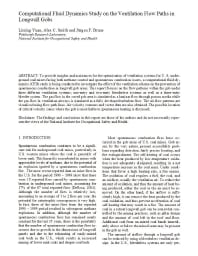Mining Publication: Computational Fluid Dynamics Study on the Ventilation Flow Paths In Longwall Gobs
Original creation date: June 2006
Authors: L Yuan, AC Smith, JF Brune
NIOSHTIC2 Number: 20030341
Proceedings of the 11th U.S./North American Mine Ventilation Symposium, University Park, Pennsylvania, June 5-7, 2006. Mutmansky JM, Ramani RV. eds., London, U.K.: Taylor & Francis Group, 2006 Jun; :591-598
To provide insights into and assistance for the optimization of ventilation systems for U.S. underground coal mines facing both methane control and spontaneous combustion issues, a computational fluid dynamics (CFD) study is being conducted to investigate the effect of the ventilation scheme on preventing spontaneous combustion in longwall gob areas. This report focuses on the flow patterns within the gob under three different ventilation systems; one-entry and two-entry bleederless systems as well as a three-entry bleeder system. The gas flow in the caved gob area is simulated as a laminar flow through porous media, while the gas flow in ventilation airways is simulated as a fully developed turbulent flow. The airflow patterns are visualized using flow path lines. Air velocity contours and vector data are also obtained. The possible location of critical velocity zones where the gob is most liable to spontaneous heating is discussed.

NIOSHTIC2 Number: 20030341
Proceedings of the 11th U.S./North American Mine Ventilation Symposium, University Park, Pennsylvania, June 5-7, 2006. Mutmansky JM, Ramani RV. eds., London, U.K.: Taylor & Francis Group, 2006 Jun; :591-598
- Advances in Grid-Based Numerical Modeling Techniques for Improving Gas Management in Coal Mines
- Computational Fluid Dynamics Modeling of Spontaneous Heating in Longwall Gob Areas
- Effect of Longwall Face Advance on Spontaneous Heating in Longwall Gob Areas
- Effects of Ventilation and Gob Characteristics on Spontaneous Heating in Longwall Gob Areas
- Numerical Study on Effects of Coal Properties on Spontaneous Heating in Longwall Gob Areas
- Prediction of Porosity and Permeability of Caved Zone in Longwall Gobs
- Remote Gob Gas Venthole Monitoring and Cellular Telephone-Based Real-Time Data Transmission System
- Simulation of Spontaneous Heating in Longwall Gob Area with a Bleederless Ventilation System
- Technology News 448 - Improving the Performance of Longwall Gob Gas Ventholes
- Validation of the Ventgraph Program for Use in Metal/Non-metal Mines